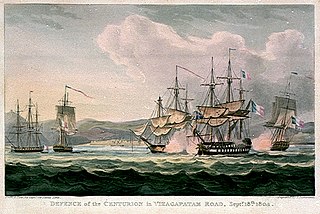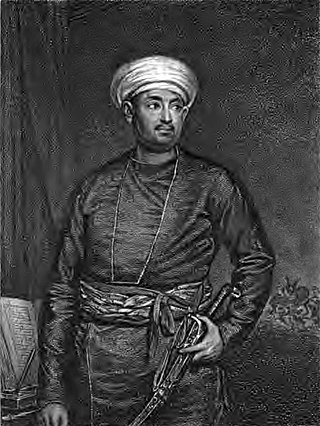HMS Russell was a 74-gun third rate ship of the line of the Royal Navy, launched on 10 November 1764 at Deptford.

Yameen-ud Daula Saadat Ali Khan II Bahadur was the sixth Nawab of Oudh from 21 January 1798 to 11 July 1814, and the son of Shuja-ud-Daula. He was of Persian origin.

Admiral Sir Pulteney Malcolm was a British naval officer. He was born at Douglan, near Langholm, Scotland, on 20 February 1768, the third son of George Malcolm of Burnfoot, Langholm, in Dumfriesshire, a sheep farmer, and his wife Margaret, the sister of Admiral Sir Thomas Pasley. His brothers were Sir James Malcolm, Sir John Malcolm, and Sir Charles Malcolm.

David Lester Richardson was an officer of the East India Company, who throughout his life followed literary pursuits as a poet and periodical writer, and as editor and proprietor of literary journals. A skilled linguist, he was in later life an educator, serving as professor of English at Hindu College, where he inspired the Bengali poet Michael Madhusudan Dutta.

HMS Calcutta was the East Indiaman Warley, converted to a Royal Navy 56-gun fourth rate. This ship of the line served for a time as an armed transport. She also transported convicts to Australia in a voyage that became a circumnavigation of the world. The French 74-gun Magnanime captured Calcutta in 1805. In 1809, after she ran aground during the Battle of the Basque Roads and her crew had abandoned her, a British boarding party burned her.

British General Charles Cornwallis, the Earl Cornwallis, was appointed in February 1786 to serve as both Commander-in-Chief of British India and Governor of the Presidency of Fort William, also known as the Bengal Presidency. He oversaw the consolidation of British control over much of peninsular India, setting the stage for the British Raj. He was also instrumental in enacting administrative and legal reforms that fundamentally altered civil administration and land management practices there. According to historian Jerry Dupont, Cornwallis was responsible for "laying the foundation for British rule throughout India and setting standards for the services, courts, and revenue collection that remained remarkably unaltered almost to the end of the British era."

Lord Nelson was an East Indiaman, launched in late 1799, sailing for the East India Company. She made five voyages, of which she completed four. On her second voyage the French privateer Bellone captured her, but the Royal Navy recaptured her within about two weeks. On her fifth voyage, Lord Nelson foundered in 1808 with the loss of all aboard.
Northampton, was a three-decker merchant ship launched in 1801 upon the River Thames, England. She made eight voyages to India as an extra (chartered) ship for the British East India Company (EIC) between 1801 and 1819. During the same period she made one separate trip transporting convicts from Britain to New South Wales, followed by a voyage for the EIC from China back to England. In 1820 she carried settlers to South Africa. She is last listed in Lloyd's Register in 1822.

Princess Charlotte was an "extra ship’’ of the British East India Company (EIC), launched in 1796. She made four voyages for the EIC. On her second voyage she suffered a short-lived mutiny and then spent almost a year as an armed ship in the service of the EIC, including a voyage to the Red Sea. A squadron of the French Navy captured her in the Vizagapatam roads in 1804, on her fourth voyage.
George Frederick Cherry (1761–1799) was a British-born political officer of the East India Company, murdered in Benares by Wazir Ali Khan as part of a minor insurrection against the British.

The Massacre of Benares is the name given to the minor and unsuccessful insurrection of Wazir Ali Khan, deposed Nawab of Awadh, at Benares in northern India in 1799, in which five British East India Company officials and civilians were murdered. Wazir Ali's uprising resulted in his imprisonment for the remainder of his life.

Mirza Abu Taleb Khan was an Indian tax-collector and administrator of Iranian stock, notable for a memoir of his travels in Britain, Europe and Asia Minor, Masir Talib fi Bilad Afranji, written between circa 1799 and 1805.
Comet was launched in 1800 on the Thames. In 1801 she made a voyage under charter to the British East India Company (EIC). On her second voyage, in 1803, the French captured her. Still, in 1804 her previous owners were able to reacquire her. She then made another voyage for the EIC. On her return she first served as a troopship and then in the West Indies trade. She apparently was lost in 1815 or 1816.
Monarch was built at Quebec in 1800. She sailed to England, being captured and recaptured shortly before arriving. In England, under new ownership, she proceeded to make five voyages for the British East India Company (EIC) as an "extra ship", that is, under voyage charter. In 1813 she became a transport, and then in 1818 or so a regular merchantman. She was broken up in 1820.
Phoenix was launched in 1804 as an East Indiaman. She made six voyages for the British East India Company (EIC), between 1805 and 1819. In 1810 and 1811 she participated as a transport in two British military campaigns. She was broken up by 1821.
Preston was launched in 1798 as an East Indiaman. She made six voyages for the British East India Company (EIC), between 1805 and 1819. In 1810 and 1811 she participated as a transport in two British military campaigns. She was sold for breaking up in 1812 but instead became a transport and a West Indiaman. She disappeared after a gale in August 1815.
Union was launched at Calcutta in 1801. She sailed to England and then made five voyages as an East Indiaman for the British East India Company (EIC), between 1805 and 1814. She was wrecked in late 1815 or early 1816.
Glory was an East Indiaman launched in 1802. She made two complete voyages as an "extra ship" for the British East India Company (EIC) before she disappeared in November 1808 while homeward bound from her third voyage. On her second voyage she participated in the British expedition to capture the Cape of Good Hope.
Lady Jane Dundas was launched in 1800 as an East Indiaman. She made four voyages for the British East India Company (EIC) and was lost in 1809 on the homeward-bound leg of her fifth voyage. She and three other Indiamen parted from the homeward-bound convoy during a gale on 18 March 1809 and were never seen again.
Marchioness of Exeter was launched in 1801 as an East Indiaman of the British East India Company (EIC). She made seven complete voyages for the EIC. She then made one more voyage to Java, sailing under a license from the EIC. Her last voyage ended in 1819.










